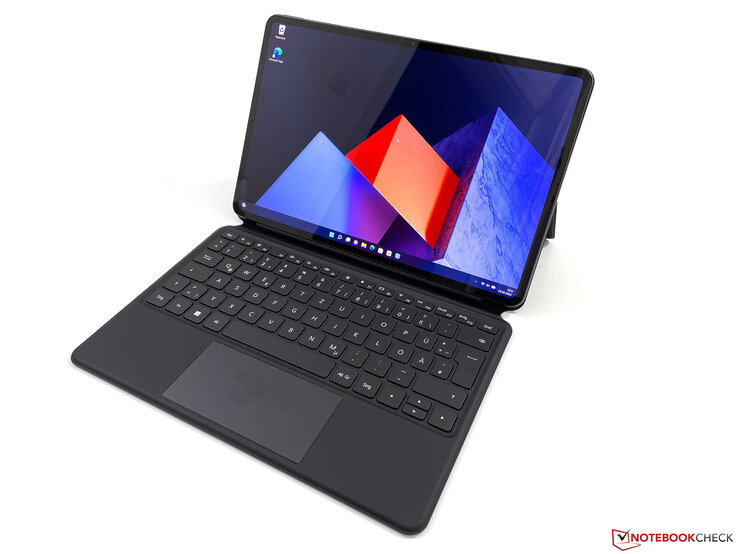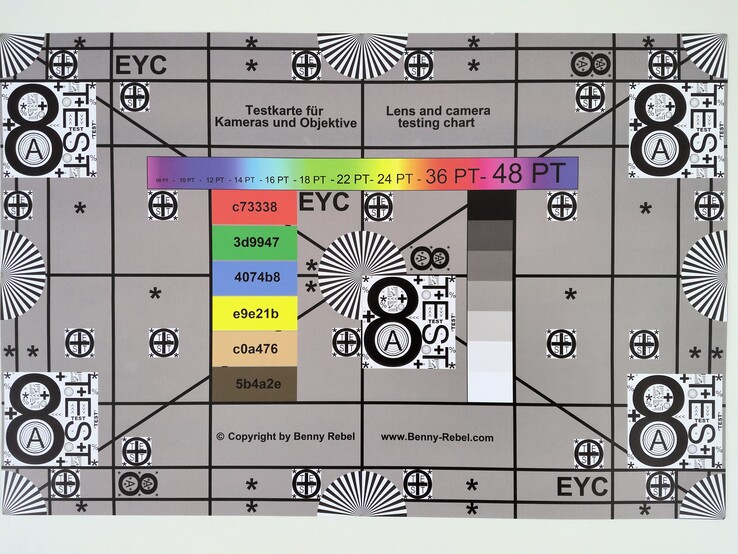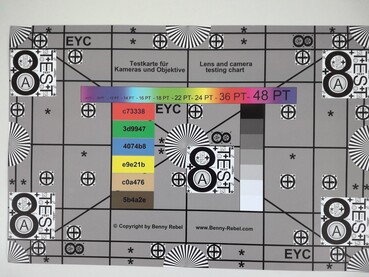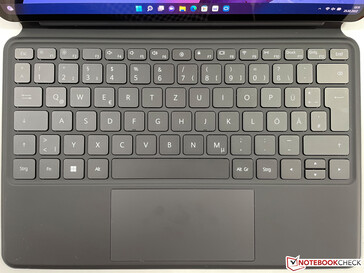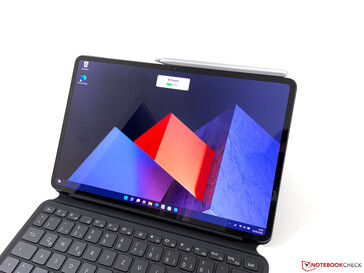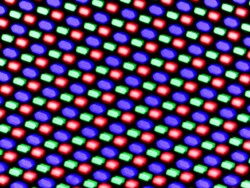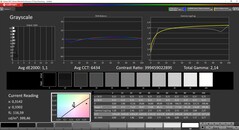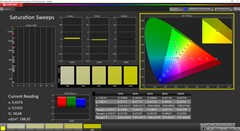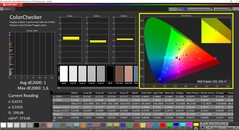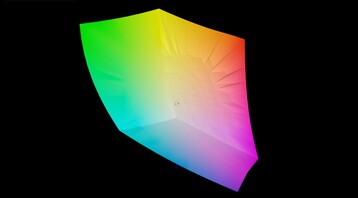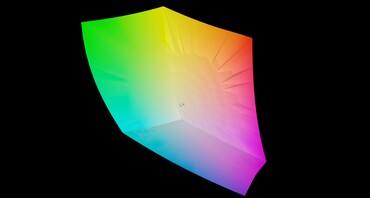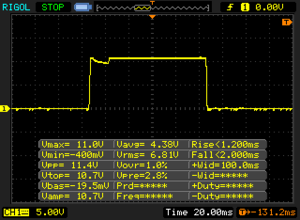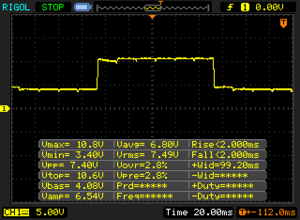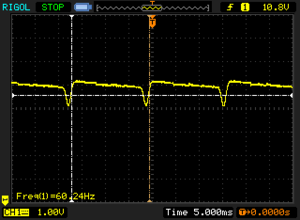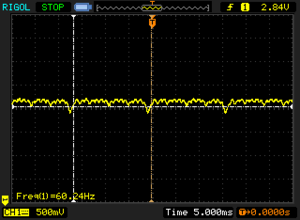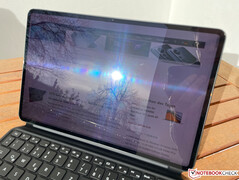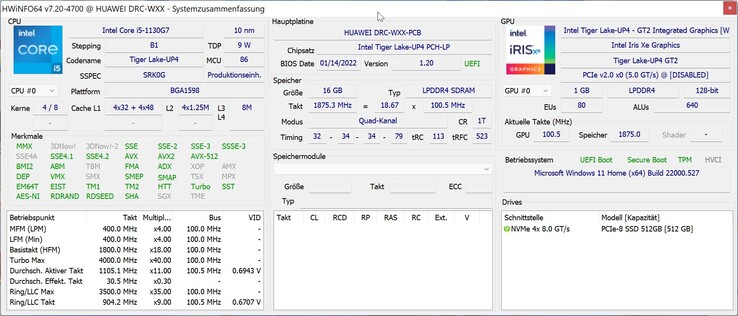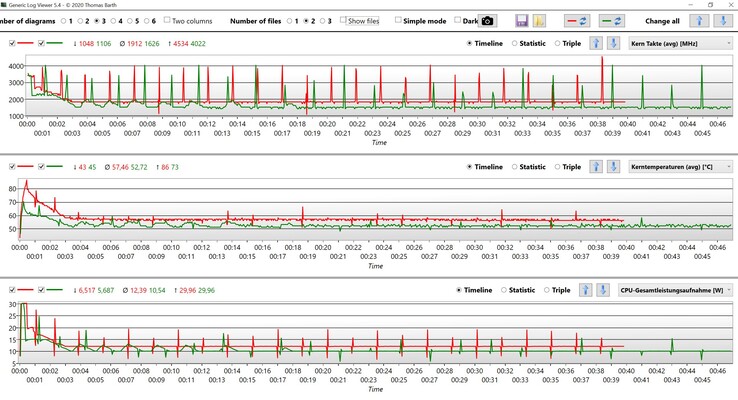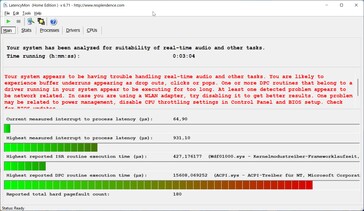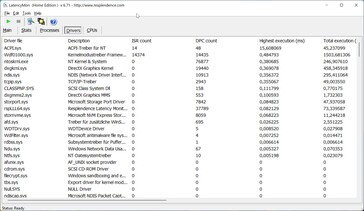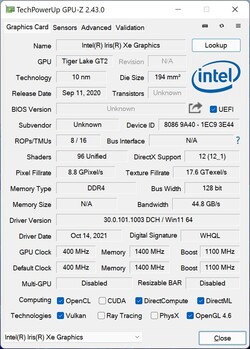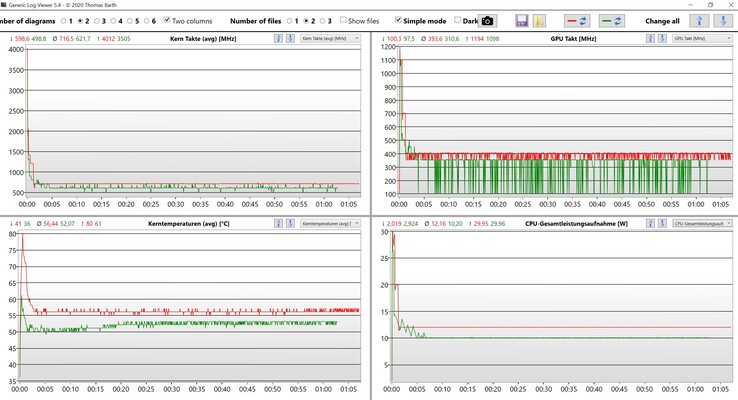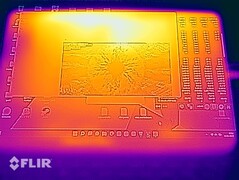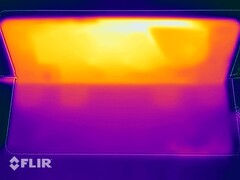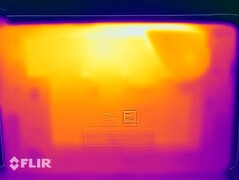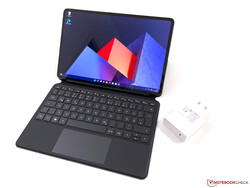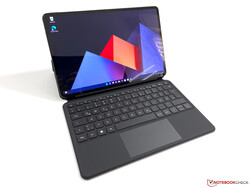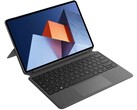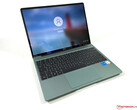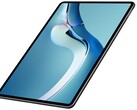Huawei MateBook E Laptop Review – A new Windows tablet with OLED

Huawei has plenty of experience with its MatePad tablet lineup and now goes one step further with the new MateBook E, a 2-in-1 laptop or convertible with Windows 11 as well as Tiger Lake UP4 processors. The manufacturer advertises it as a convertible, but contrary to pretty much any other model on the market, there is no integrated kickstand, so it is basically a Windows tablet.
Huawei uses efficient UP4 versions of the mobile Intel Tiger Lake processors and offers two SKUs, one with a Core i3 processor, 8 GB RAM, and 128 GB SSD storage for 649 Euros, and our review unit with a Core i5 chip, 16 GB RAM, and 512 GB SSD storage for 1199 Euros. Core i5 units are automatically shipped with the corresponding keyboard cover. All models feature the same 12.6-inch OLED screen with a resolution of 2560 x 1600 pixels (16:10).
Possible competitors
Rating | Date | Model | Weight | Height | Size | Resolution | Price |
|---|---|---|---|---|---|---|---|
| 85.3 % v7 (old) | 03 / 2022 | Huawei MateBook E Core i5 i5-1130G7, Iris Xe G7 80EUs | 719 g | 7.99 mm | 12.60" | 2560x1600 | |
| 89.1 % v7 (old) | 11 / 2021 | Microsoft Surface Pro 8, i7-1185G7 i7-1185G7, Iris Xe G7 96EUs | 891 g | 8.5 mm | 13.00" | 2880x1920 | |
| 87.1 % v7 (old) | 11 / 2020 | Lenovo Yoga Duet 7 13IML05-82AS000WGE i5-10210U, UHD Graphics 620 | 1.2 kg | 9.2 mm | 13.00" | 2160x1350 | |
| 88.8 % v7 (old) | 10 / 2021 | Huawei MatePad Pro 12.6 2021 Kirin 9000E, Mali-G78 MP22 | 609 g | 6.7 mm | 12.60" | 2560x1600 | |
| 91.3 % v7 (old) | 06 / 2021 | Apple iPad Pro 12.9 2021 A2378 M1, M1 8-Core GPU | 682 g | 6.4 mm | 12.90" | 2732x2048 |
Case - Like a MatePad Pro
It is not easy to distinguish the new MateBook E from the MatePad Pro based on the design, because both the visuals in Nebula Gray as well as the chassis design with rounded corner is pretty much identical between the two units. The bezels are just 5.6 mm wide and results in a high body-to-screen ratio of almost 90 percent. Both the build quality as well as the stability of the tablet are very good and there are no creaking sounds or picture distortions when we tried to twist the device. The rear of the tablet is made of a slightly roughened and offers good grip, but you can quickly see fingerprints and it is not easy to clean the surface, either.
A direct comparison with the MatePad Pro reveals the fan exhausts at the top, which are required for the active cooling solution. The buttons are very well integrated and do not rattle around, and the power button also implements a fingerprint scanner. It is also possible to attach the optional M-Pencil magnetically at the top edge, but more on that later.
We already mentioned that the MateBook E does not offer an integrated kickstand. The problem is that Windows is much harder to operate just with your fingers compared to Huawei’s own HarmonyOS on the MatePad Pro, for example, so the use of the keyboard cover (including the touchpad) is recommended. The connection with the tablet is very stable and the quality of the keyboard cover also leaves a decent impression. The black material is slightly rubberized and smooth.
Despite the active cooling solution, the tablet only tips the scale at little more than 700 grams and is therefore lighter than convertibles like the Surface Pro. The weight of the full package with the keyboard cover is around 1.15 kg, so it is still a very compact unit.
Connectivity - Huawei uses Thunderbolt 4
Huawei does not save money in terms of ports, because you get a modern USB-C port including full Thunderbolt 4 support. However, you are limited because there is only one port. If you want to attach an external screen, for instance, it should be one with power delivery via USB-C, otherwise the MateBook E will have to run on battery power. Always disconnecting the power adapter when you want to attach a USB drive or external hard drives can be annoying during productive tasks as well. We will later see that the battery runtime of the MateBook E is not great, so you will have to use the power adapter quite often.
Communication - Huawei implements Wi-Fi 6, but no LTE or 5G
Like other modern Windows devices, the MateBook E is quipped with a modern Wi-Fi module (in this case Intel AX201) including support for Wi-Fi 6 as well as Bluetooth 5.1. The transfer rates are very good in combination with our reference router from Netgear (Nighthawk AX12) and we did not notice any signal issues during our review period. Huawei also offers the HuaweiShare technology, which can be used to transfer files between compatible Huawei devices (from smartphone to a MateBook, for example) and is similar to Apple’s Air Drop technology. There is no option for an LTE or even 5G modem, though.
Webcam
The close relationship to the MatePad Pro pays off when we look at the webcams, because they are very good for a Windows device. In addition to a 13 MP sensor (f/1.8, auto focus) on the rear, which can be supported by a flash, Huawei also implements an 8 MP sensor (f/2.0, fix focus) on the front. The quality is much better compared to usual 720p modules and the MateBook E just takes much sharper images and is also very well-suited for video conferences.
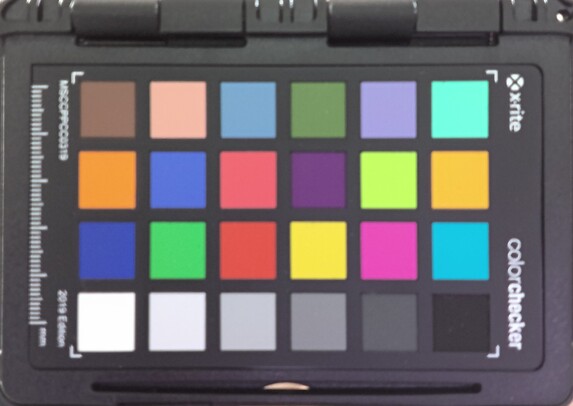
Input Devices - Smart Magnetic Keyboard without illumination
The Core i5 SKUs of the new MateBook E are shipped with the new Huawei Smart Magnetic Keyboard by default. It is a keyboard cover including a touchpad and adjustable stand. Windows is still harder to use via touch inputs compared to mobile operating systems and the MateBook E does not have an integrated stand, so the keyboard cover is pretty much a must-have also for the less expensive Core i3 unit.
The keyboard itself has pretty shallow keys, but the typing experience is still okay thanks to the precise and also pretty quiet key strokes. The layout is a bit cramped at the right side and the vertical arrow keys are very small, but the bigger issue is the lack of illuminated keys.
The small clickpad underneath the keyboard (11.3 x 5.7 cm) works well and offers good gliding capabilities, but the unit on our model was a bit clattery. This was also noticeable when we juts tapped the surface or repositioned our fingers. If you depress the pad in the lower half, you are also confronted with a very loud clicking sound. We would recommend an external Bluetooth mouse, at least when you use it as a stationary device.
You can obviously use the capacitive touchscreen for inputs, which works very well. Huawei also offers the optional M-Pencil (first or second generation). It can be attached to the top of the tablet via magnet and is automatically charged and connected (Bluetooth). We cannot tell you anything about the new second generation M-Pencil, but we could test a first-generation model we still had from a MatePad pro. Inputs worked well, but the resistance from the touchscreen surface during writing was a bit high.
Display - MateBook E with 16:10 OLED
The highlight of the new MateBook E is definitely the display, because Huawei uses a 12.6-inch OLED touchscreen with a resolution of 2560 x 1600 pixels (16:10). The subjective picture impression is excellent thanks to the high resolution and very high contrast ratio, which create crisp and vivid images. Due to the rounded edges of the bezels, the picture contents are a slightly hidden in the corners. This is not a big deal in practice, but it is visible nonetheless.
Huawei advertises a brightness of 400 nits and we can confirm this value after our measurements. As it is typical for OLED screens, the black value is 0, so the contrast ratio in infinite in theory. The manufacturer also advertises an optional high-brightness mode with a brightness of up to 600 nits, but we were not able to find a corresponding option in the software, via key combination, or with the brightness sensor. We have already contacted the manufacturer and we will publish the answer as soon as we get it.
Backlight bleeding is no problem for OLED screens, but we can detect the typical PWM flickering at 60 Hz as soon as the brightness drops to 80% (corresponds with a brightness of 226 nits) or lower. The two screenshots in the PWM box below show the PWM flickering at 80 and 40% brightness. If you are sensitive to PWM flickering and maybe already noticed problems with OLED smartphones, you will probably not be happy with the new MateBook E.
| |||||||||||||||||||||||||
Brightness Distribution: 94 %
Center on Battery: 401 cd/m²
Contrast: ∞:1 (Black: 0 cd/m²)
ΔE ColorChecker Calman: 1 | ∀{0.5-29.43 Ø4.78}
ΔE Greyscale Calman: 1.1 | ∀{0.09-98 Ø5}
72.9% AdobeRGB 1998 (Argyll 3D)
100% sRGB (Argyll 3D)
99.9% Display P3 (Argyll 3D)
Gamma: 2.14
CCT: 6434 K
| Huawei MateBook E Core i5 EDOC660, OLED, 2560x1600, 12.6" | Microsoft Surface Pro 8, i7-1185G7 LP129WT212166, IPS, 2880x1920, 13" | Lenovo Yoga Duet 7 13IML05-82AS000WGE CSOT T3 LEN8290, IPS, 2160x1350, 13" | Huawei MatePad Pro 12.6 2021 OLED, 2560x1600, 12.6" | Apple iPad Pro 12.9 2021 A2378 Liquid Retina XDR, IPS mini-LED, 2732x2048, 12.9" | |
|---|---|---|---|---|---|
| Display | -5% | -12% | -11% | ||
| Display P3 Coverage (%) | 99.9 | 78.2 -22% | 68.9 -31% | 68.7 -31% | |
| sRGB Coverage (%) | 100 | 100 0% | 98.2 -2% | 99.9 0% | |
| AdobeRGB 1998 Coverage (%) | 72.9 | 77.6 6% | 71.1 -2% | 70.5 -3% | |
| Response Times | -843% | -1032% | -39% | -1103% | |
| Response Time Grey 50% / Grey 80% * (ms) | 4 ? | 46.4 ? -1060% | 58 ? -1350% | 5.6 ? -40% | 40 ? -900% |
| Response Time Black / White * (ms) | 3.2 ? | 23.2 ? -625% | 26 ? -713% | 4.4 ? -38% | 45 ? -1306% |
| PWM Frequency (Hz) | 60.2 ? | 29760 ? | 61 ? | 19190 ? | |
| Screen | -41% | -239% | -57% | -60% | |
| Brightness middle (cd/m²) | 399 | 444 11% | 450 13% | 383 -4% | 620 55% |
| Brightness (cd/m²) | 407 | 451 11% | 411 1% | 390 -4% | 612 50% |
| Brightness Distribution (%) | 94 | 91 -3% | 83 -12% | 94 0% | 96 2% |
| Black Level * (cd/m²) | 0.43 | 0.22 | |||
| Colorchecker dE 2000 * | 1 | 2 -100% | 4.15 -315% | 2.1 -110% | 1.8 -80% |
| Colorchecker dE 2000 max. * | 1.6 | 3.2 -100% | 11.49 -618% | 3.7 -131% | 4.9 -206% |
| Greyscale dE 2000 * | 1.1 | 1.8 -64% | 6.66 -505% | 2.1 -91% | 3.1 -182% |
| Gamma | 2.14 103% | 2.11 104% | 2.42 91% | 2.14 103% | 2214 0% |
| CCT | 6434 101% | 6417 101% | 6043 108% | 6258 104% | 6892 94% |
| Contrast (:1) | 1033 | 2045 | |||
| Colorchecker dE 2000 calibrated * | 1.7 | 1.09 | |||
| Color Space (Percent of AdobeRGB 1998) (%) | 65 | ||||
| Color Space (Percent of sRGB) (%) | 98 | ||||
| Total Average (Program / Settings) | -296% /
-177% | -428% /
-321% | -48% /
-52% | -391% /
-236% |
* ... smaller is better
Like on other MateBooks, you get additional display software to adjust some aspects like the color temperature, a blue light filter or in the case of the MateBook E even the color space (sRGB or P3). You also have the option to automatically adjust the color temperature based on the environment via brightness sensor.
Our analysis with the professional CalMAN software (X-Rite i1 Pro 2) shows that the picture quality is already excellent out of the box. There is no visible color cast and the DeltaE-2000 deviations compared to the P3 reference color space are already below the important mark of 3. Combined with the full P3 color gamut, it is no problem to edit pictures/videos.
We were not able to improve the display performance with our own calibration, so we do not offer a profile at this point.
Display Response Times
| ↔ Response Time Black to White | ||
|---|---|---|
| 3.2 ms ... rise ↗ and fall ↘ combined | ↗ 1.2 ms rise | |
| ↘ 2 ms fall | ||
| The screen shows very fast response rates in our tests and should be very well suited for fast-paced gaming. In comparison, all tested devices range from 0.1 (minimum) to 240 (maximum) ms. » 13 % of all devices are better. This means that the measured response time is better than the average of all tested devices (20.2 ms). | ||
| ↔ Response Time 50% Grey to 80% Grey | ||
| 4 ms ... rise ↗ and fall ↘ combined | ↗ 2 ms rise | |
| ↘ 2 ms fall | ||
| The screen shows very fast response rates in our tests and should be very well suited for fast-paced gaming. In comparison, all tested devices range from 0.165 (minimum) to 636 (maximum) ms. » 14 % of all devices are better. This means that the measured response time is better than the average of all tested devices (31.6 ms). | ||
Screen Flickering / PWM (Pulse-Width Modulation)
| Screen flickering / PWM detected | 60.2 Hz | ≤ 80 % brightness setting | |
| ≤ 226 cd/m² brightness | |||
The display backlight flickers at 60.2 Hz (worst case, e.g., utilizing PWM) Flickering detected at a brightness setting of 80 % (226 cd/m²) and below. There should be no flickering or PWM above this brightness setting. The frequency of 60.2 Hz is very low, so the flickering may cause eyestrain and headaches after extended use. Flickering occurs even at high brightness setting and may have an effect on the user during everyday use. In comparison: 53 % of all tested devices do not use PWM to dim the display. If PWM was detected, an average of 8108 (minimum: 5 - maximum: 343500) Hz was measured. | |||
The advertised high-brightness mode would certainly help on very bright and sunny days, because reflections from the glossy touchscreen are definitely an issue. You should look for a place in the shade in order to see the display contents. The overall viewing angle stability of the OLED panel is very good, but there is the OLED typical blue shimmer from certain angles.
Performance - Tiger Lake-UP4
The MateBook E is equipped with Intel Tiger Lake CPUs, but only the very efficient UP4 models, which are operated at much lower TDP values compared to the usual UP3 model like the Core i5-1135G7, which is familiar from many modern ultrabooks. In addition to the Core i5 (4 cores) in our review unit, you can also get an entry-level SKU with the Core i3-1110G4 with just two cores and also a slower version of the iGPU.
Review Settings
Huawei usually equips its MateBooks with an optional Performance mode, and the new MateBook E is no exception. You can activate it via PC Manager software or key combination (Fn + P). The CPU can consume up to 30 Watts for short periods of time in both modes, but quickly levels off at 10 Watts (Balanced) or 12 Watts (Performance), respectively, so there is not a huge difference. We performed the following benchmarks and measurements with the default Balanced mode in general and only checked the effect of the Performance mode in some sections.
Processor - Core i5-1130G7
Intel’s Core i5-1130G7 is a Tiger Lake-UP4 chip and has four cores (eight threads) with a maximum clock of up to 4 GHz or 3.4 GHz for all active cores, respectively. The short-term power consumption is set to 30 Watts, which ensures solid performance figures in peak load scenarios, which are very common during everyday workloads. The performance quickly drops under sustained workloads and the overall performance level is pretty low when you consider the price of 1200 Euros. The results are a bit better with the optional Performance mode, but they are still low in general. The performance does not drop any further on battery power. More benchmark results are available in our CPU section.
Cinebench R15 Multi Loop
Cinebench R23: Multi Core | Single Core
Cinebench R20: CPU (Multi Core) | CPU (Single Core)
Cinebench R15: CPU Multi 64Bit | CPU Single 64Bit
Blender: v2.79 BMW27 CPU
7-Zip 18.03: 7z b 4 | 7z b 4 -mmt1
Geekbench 5.5: Multi-Core | Single-Core
HWBOT x265 Benchmark v2.2: 4k Preset
LibreOffice : 20 Documents To PDF
R Benchmark 2.5: Overall mean
| CPU Performance rating | |
| Average of class Convertible | |
| Apple iPad Pro 12.9 2021 A2378 -12! | |
| Microsoft Surface Pro 8, i7-1185G7 | |
| Average Intel Core i5-1130G7 | |
| Huawei MateBook E Core i5 | |
| Lenovo Yoga Duet 7 13IML05-82AS000WGE -2! | |
| Cinebench R23 / Multi Core | |
| Average of class Convertible (2949 - 29063, n=56, last 2 years) | |
| Microsoft Surface Pro 8, i7-1185G7 | |
| Average Intel Core i5-1130G7 (2237 - 3240, n=2) | |
| Huawei MateBook E Core i5 | |
| Cinebench R23 / Single Core | |
| Average of class Convertible (914 - 2163, n=56, last 2 years) | |
| Microsoft Surface Pro 8, i7-1185G7 | |
| Average Intel Core i5-1130G7 (1077 - 1226, n=2) | |
| Huawei MateBook E Core i5 | |
| Cinebench R20 / CPU (Multi Core) | |
| Average of class Convertible (1124 - 11357, n=56, last 2 years) | |
| Microsoft Surface Pro 8, i7-1185G7 | |
| Average Intel Core i5-1130G7 (870 - 1251, n=2) | |
| Huawei MateBook E Core i5 | |
| Lenovo Yoga Duet 7 13IML05-82AS000WGE | |
| Cinebench R20 / CPU (Single Core) | |
| Average of class Convertible (348 - 827, n=56, last 2 years) | |
| Microsoft Surface Pro 8, i7-1185G7 | |
| Average Intel Core i5-1130G7 (418 - 478, n=2) | |
| Huawei MateBook E Core i5 | |
| Lenovo Yoga Duet 7 13IML05-82AS000WGE | |
| Cinebench R15 / CPU Multi 64Bit | |
| Average of class Convertible (478 - 4830, n=59, last 2 years) | |
| Microsoft Surface Pro 8, i7-1185G7 | |
| Huawei MateBook E Core i5 | |
| Huawei MateBook E Core i5 | |
| Lenovo Yoga Duet 7 13IML05-82AS000WGE | |
| Average Intel Core i5-1130G7 (564 - 700, n=4) | |
| Cinebench R15 / CPU Single 64Bit | |
| Average of class Convertible (149.8 - 317, n=56, last 2 years) | |
| Microsoft Surface Pro 8, i7-1185G7 | |
| Lenovo Yoga Duet 7 13IML05-82AS000WGE | |
| Average Intel Core i5-1130G7 (114 - 189.7, n=3) | |
| Huawei MateBook E Core i5 | |
| Blender / v2.79 BMW27 CPU | |
| Lenovo Yoga Duet 7 13IML05-82AS000WGE | |
| Huawei MateBook E Core i5 | |
| Average Intel Core i5-1130G7 (1124 - 1255, n=2) | |
| Microsoft Surface Pro 8, i7-1185G7 | |
| Average of class Convertible (107 - 1051, n=55, last 2 years) | |
| 7-Zip 18.03 / 7z b 4 | |
| Average of class Convertible (12977 - 121368, n=56, last 2 years) | |
| Microsoft Surface Pro 8, i7-1185G7 | |
| Huawei MateBook E Core i5 | |
| Average Intel Core i5-1130G7 (14453 - 14999, n=2) | |
| Lenovo Yoga Duet 7 13IML05-82AS000WGE | |
| 7-Zip 18.03 / 7z b 4 -mmt1 | |
| Average of class Convertible (3672 - 6540, n=56, last 2 years) | |
| Microsoft Surface Pro 8, i7-1185G7 | |
| Average Intel Core i5-1130G7 (4094 - 4256, n=2) | |
| Huawei MateBook E Core i5 | |
| Lenovo Yoga Duet 7 13IML05-82AS000WGE | |
| Geekbench 5.5 / Multi-Core | |
| Average of class Convertible (2188 - 22023, n=55, last 2 years) | |
| Apple iPad Pro 12.9 2021 A2378 | |
| Microsoft Surface Pro 8, i7-1185G7 | |
| Average Intel Core i5-1130G7 (4710 - 4894, n=2) | |
| Huawei MateBook E Core i5 | |
| Lenovo Yoga Duet 7 13IML05-82AS000WGE | |
| Geekbench 5.5 / Single-Core | |
| Average of class Convertible (806 - 2275, n=55, last 2 years) | |
| Apple iPad Pro 12.9 2021 A2378 | |
| Microsoft Surface Pro 8, i7-1185G7 | |
| Huawei MateBook E Core i5 | |
| Average Intel Core i5-1130G7 (1306 - 1337, n=2) | |
| Lenovo Yoga Duet 7 13IML05-82AS000WGE | |
| HWBOT x265 Benchmark v2.2 / 4k Preset | |
| Average of class Convertible (3.43 - 36.2, n=56, last 2 years) | |
| Microsoft Surface Pro 8, i7-1185G7 | |
| Huawei MateBook E Core i5 | |
| Average Intel Core i5-1130G7 (n=1) | |
| Lenovo Yoga Duet 7 13IML05-82AS000WGE | |
| LibreOffice / 20 Documents To PDF | |
| Lenovo Yoga Duet 7 13IML05-82AS000WGE | |
| Average Intel Core i5-1130G7 (57.7 - 58.9, n=2) | |
| Huawei MateBook E Core i5 | |
| Average of class Convertible (42.5 - 84.3, n=55, last 2 years) | |
| Microsoft Surface Pro 8, i7-1185G7 | |
| R Benchmark 2.5 / Overall mean | |
| Lenovo Yoga Duet 7 13IML05-82AS000WGE | |
| Huawei MateBook E Core i5 | |
| Average Intel Core i5-1130G7 (0.714 - 0.753, n=2) | |
| Microsoft Surface Pro 8, i7-1185G7 | |
| Average of class Convertible (0.3985 - 0.84, n=55, last 2 years) | |
* ... smaller is better
AIDA64: FP32 Ray-Trace | FPU Julia | CPU SHA3 | CPU Queen | FPU SinJulia | FPU Mandel | CPU AES | CPU ZLib | FP64 Ray-Trace | CPU PhotoWorxx
| Performance rating | |
| Average of class Convertible | |
| Microsoft Surface Pro 8, i7-1185G7 | |
| Average Intel Core i5-1130G7 | |
| Huawei MateBook E Core i5 | |
| Lenovo Yoga Duet 7 13IML05-82AS000WGE | |
| AIDA64 / FP32 Ray-Trace | |
| Average of class Convertible (1480 - 64158, n=55, last 2 years) | |
| Microsoft Surface Pro 8, i7-1185G7 | |
| Average Intel Core i5-1130G7 (3370 - 5199, n=2) | |
| Huawei MateBook E Core i5 | |
| Lenovo Yoga Duet 7 13IML05-82AS000WGE | |
| AIDA64 / FPU Julia | |
| Average of class Convertible (11392 - 183760, n=55, last 2 years) | |
| Microsoft Surface Pro 8, i7-1185G7 | |
| Average Intel Core i5-1130G7 (16379 - 20972, n=2) | |
| Huawei MateBook E Core i5 | |
| Lenovo Yoga Duet 7 13IML05-82AS000WGE | |
| AIDA64 / CPU SHA3 | |
| Average of class Convertible (797 - 8151, n=55, last 2 years) | |
| Microsoft Surface Pro 8, i7-1185G7 | |
| Average Intel Core i5-1130G7 (1205 - 1477, n=2) | |
| Huawei MateBook E Core i5 | |
| Lenovo Yoga Duet 7 13IML05-82AS000WGE | |
| AIDA64 / CPU Queen | |
| Average of class Convertible (14686 - 145339, n=55, last 2 years) | |
| Microsoft Surface Pro 8, i7-1185G7 | |
| Lenovo Yoga Duet 7 13IML05-82AS000WGE | |
| Average Intel Core i5-1130G7 (41459 - 41466, n=2) | |
| Huawei MateBook E Core i5 | |
| AIDA64 / FPU SinJulia | |
| Average of class Convertible (1120 - 29155, n=55, last 2 years) | |
| Microsoft Surface Pro 8, i7-1185G7 | |
| Average Intel Core i5-1130G7 (2658 - 3861, n=2) | |
| Lenovo Yoga Duet 7 13IML05-82AS000WGE | |
| Huawei MateBook E Core i5 | |
| AIDA64 / FPU Mandel | |
| Average of class Convertible (4929 - 97193, n=55, last 2 years) | |
| Microsoft Surface Pro 8, i7-1185G7 | |
| Average Intel Core i5-1130G7 (9932 - 12746, n=2) | |
| Huawei MateBook E Core i5 | |
| Lenovo Yoga Duet 7 13IML05-82AS000WGE | |
| AIDA64 / CPU AES | |
| Average Intel Core i5-1130G7 (45912 - 55456, n=2) | |
| Average of class Convertible (15752 - 139734, n=55, last 2 years) | |
| Huawei MateBook E Core i5 | |
| Microsoft Surface Pro 8, i7-1185G7 | |
| Lenovo Yoga Duet 7 13IML05-82AS000WGE | |
| AIDA64 / CPU ZLib | |
| Average of class Convertible (218 - 2001, n=55, last 2 years) | |
| Microsoft Surface Pro 8, i7-1185G7 | |
| Average Intel Core i5-1130G7 (227 - 325, n=2) | |
| Huawei MateBook E Core i5 | |
| Lenovo Yoga Duet 7 13IML05-82AS000WGE | |
| AIDA64 / FP64 Ray-Trace | |
| Average of class Convertible (1169 - 34297, n=55, last 2 years) | |
| Microsoft Surface Pro 8, i7-1185G7 | |
| Average Intel Core i5-1130G7 (1830 - 2601, n=2) | |
| Huawei MateBook E Core i5 | |
| Lenovo Yoga Duet 7 13IML05-82AS000WGE | |
| AIDA64 / CPU PhotoWorxx | |
| Average of class Convertible (14193 - 81626, n=55, last 2 years) | |
| Microsoft Surface Pro 8, i7-1185G7 | |
| Average Intel Core i5-1130G7 (32482 - 37334, n=2) | |
| Huawei MateBook E Core i5 | |
| Lenovo Yoga Duet 7 13IML05-82AS000WGE | |
System Performance
The subjective performance impression of the MateBook E is solid and there is plenty of RAM at 16 GB, but there can be some stutters or delays when you stress the system a bit more. We notice it during the installation of applications, for example, where there was not much headroom for additional tasks. As long as you only use it for common tasks, however, there should not be any issues.
CrossMark: Overall | Productivity | Creativity | Responsiveness
| PCMark 10 / Score | |
| Average of class Convertible (3229 - 9125, n=53, last 2 years) | |
| Microsoft Surface Pro 8, i7-1185G7 | |
| Average Intel Core i5-1130G7, Intel Iris Xe Graphics G7 80EUs (4082 - 4482, n=2) | |
| Huawei MateBook E Core i5 | |
| Lenovo Yoga Duet 7 13IML05-82AS000WGE | |
| PCMark 10 / Essentials | |
| Average of class Convertible (7233 - 12222, n=53, last 2 years) | |
| Microsoft Surface Pro 8, i7-1185G7 | |
| Average Intel Core i5-1130G7, Intel Iris Xe Graphics G7 80EUs (8873 - 10226, n=2) | |
| Huawei MateBook E Core i5 | |
| Lenovo Yoga Duet 7 13IML05-82AS000WGE | |
| PCMark 10 / Productivity | |
| Average of class Convertible (5062 - 10643, n=53, last 2 years) | |
| Microsoft Surface Pro 8, i7-1185G7 | |
| Lenovo Yoga Duet 7 13IML05-82AS000WGE | |
| Average Intel Core i5-1130G7, Intel Iris Xe Graphics G7 80EUs (5875 - 6004, n=2) | |
| Huawei MateBook E Core i5 | |
| PCMark 10 / Digital Content Creation | |
| Average of class Convertible (2496 - 16551, n=53, last 2 years) | |
| Microsoft Surface Pro 8, i7-1185G7 | |
| Average Intel Core i5-1130G7, Intel Iris Xe Graphics G7 80EUs (3543 - 3982, n=2) | |
| Huawei MateBook E Core i5 | |
| Lenovo Yoga Duet 7 13IML05-82AS000WGE | |
| CrossMark / Overall | |
| Average of class Convertible (524 - 2274, n=56, last 2 years) | |
| Microsoft Surface Pro 8, i7-1185G7 | |
| Apple iPad Pro 12.9 2021 A2378 | |
| Huawei MateBook E Core i5 | |
| Average Intel Core i5-1130G7, Intel Iris Xe Graphics G7 80EUs (n=1) | |
| CrossMark / Productivity | |
| Average of class Convertible (554 - 1925, n=56, last 2 years) | |
| Microsoft Surface Pro 8, i7-1185G7 | |
| Huawei MateBook E Core i5 | |
| Average Intel Core i5-1130G7, Intel Iris Xe Graphics G7 80EUs (n=1) | |
| Apple iPad Pro 12.9 2021 A2378 | |
| CrossMark / Creativity | |
| Average of class Convertible (550 - 2949, n=56, last 2 years) | |
| Apple iPad Pro 12.9 2021 A2378 | |
| Microsoft Surface Pro 8, i7-1185G7 | |
| Huawei MateBook E Core i5 | |
| Average Intel Core i5-1130G7, Intel Iris Xe Graphics G7 80EUs (n=1) | |
| CrossMark / Responsiveness | |
| Huawei MateBook E Core i5 | |
| Average Intel Core i5-1130G7, Intel Iris Xe Graphics G7 80EUs (n=1) | |
| Average of class Convertible (381 - 1719, n=56, last 2 years) | |
| Microsoft Surface Pro 8, i7-1185G7 | |
| Apple iPad Pro 12.9 2021 A2378 | |
| PCMark 10 Score | 4082 points | |
Help | ||
| AIDA64 / Memory Copy | |
| Average of class Convertible (23880 - 158525, n=55, last 2 years) | |
| Microsoft Surface Pro 8, i7-1185G7 | |
| Average Intel Core i5-1130G7 (56482 - 59281, n=2) | |
| Huawei MateBook E Core i5 | |
| Lenovo Yoga Duet 7 13IML05-82AS000WGE | |
| AIDA64 / Memory Read | |
| Average of class Convertible (19931 - 126725, n=55, last 2 years) | |
| Average Intel Core i5-1130G7 (56256 - 61956, n=2) | |
| Microsoft Surface Pro 8, i7-1185G7 | |
| Huawei MateBook E Core i5 | |
| Lenovo Yoga Duet 7 13IML05-82AS000WGE | |
| AIDA64 / Memory Write | |
| Average of class Convertible (17473 - 216896, n=55, last 2 years) | |
| Average Intel Core i5-1130G7 (58608 - 65584, n=2) | |
| Microsoft Surface Pro 8, i7-1185G7 | |
| Huawei MateBook E Core i5 | |
| Lenovo Yoga Duet 7 13IML05-82AS000WGE | |
| AIDA64 / Memory Latency | |
| Average of class Convertible (6.9 - 536, n=54, last 2 years) | |
| Microsoft Surface Pro 8, i7-1185G7 | |
| Huawei MateBook E Core i5 | |
| Average Intel Core i5-1130G7 (92.8 - 93.4, n=2) | |
| Lenovo Yoga Duet 7 13IML05-82AS000WGE | |
* ... smaller is better
DPC Lateny
| DPC Latencies / LatencyMon - interrupt to process latency (max), Web, Youtube, Prime95 | |
| Lenovo Yoga Duet 7 13IML05-82AS000WGE | |
| Huawei MateBook E Core i5 | |
| Microsoft Surface Pro 8, i7-1185G7 | |
* ... smaller is better
Storage Devices
Huawei uses an M.2-SSD, which is attached via PCIe 3.0 x4 interface and the benchmark performance is good, so there should not be any limitations. The SSD offers a storage capacity of 512 GB, and you can use around 408 GB for your own files/apps after the initial set-up. Like on other current MateBooks, however, the SSD is partitioned and you only get 72 GB on the system drive. This can quickly result in capacity problems when you are not careful with installations and downloads. We once again think this is completely unnecessary and we can only hope Huawei will discontinue this method for future products. More SSD benchmarks are available here.
| Drive Performance rating - Percent | |
| Average Silicon Motion PCIe-8 SSD | |
| Huawei MateBook E Core i5 | |
| Average of class Convertible | |
| Microsoft Surface Pro 8, i7-1185G7 | |
| Lenovo Yoga Duet 7 13IML05-82AS000WGE | |
* ... smaller is better
Disk Throttling: DiskSpd Read Loop, Queue Depth 8
GPU Performance - Iris Xe Graphics G7
All the graphics calculations are handled by the standard Iris Xe Graphics G7 with 80 EUs, which is also used in Tiger Lake-U chips like the Core i5-1135G7. This iGPU is a good choice for everyday workloads and high-resolution video playback is also no problem thanks to the powerful video decoder. The iGPU is, however, hardly suited for gaming. The general performance is very low and it will drop by another 30% after a couple of minutes. You should focus on very old or very simple games from the Windows store. The performance is at least not further reduced on battery power. Please see our Tech section for more GPU benchmarks.
| 3DMark 11 Performance | 3764 points | |
| 3DMark Cloud Gate Standard Score | 12877 points | |
| 3DMark Fire Strike Score | 2646 points | |
| 3DMark Time Spy Score | 865 points | |
Help | ||
Witcher 3 FPS Chart (medium settings)
| low | med. | high | ultra | QHD | |
|---|---|---|---|---|---|
| GTA V (2015) | 57.9 | 39.2 | 13.2 | ||
| The Witcher 3 (2015) | 39 | 23.9 | 13 | ||
| Dota 2 Reborn (2015) | 76.6 | 28.3 | 21.2 | 20.8 | |
| Final Fantasy XV Benchmark (2018) | 21.7 | 12.1 | 7.56 | 5.8 | |
| X-Plane 11.11 (2018) | 12.4 | 11.1 | 10.3 | ||
| Far Cry 5 (2018) | 25 | 15 | 13 | 12 | |
| Strange Brigade (2018) | 59.4 | 19.6 | 15.7 | 13.6 | |
| F1 2021 (2021) | 69.1 | 26.3 | 26.2 | 15 |
Emissions - MateBook E with great speakers
System Noise
The MateBook E uses a small fan which is quickly activated under load. The measurement results are pretty low, but the fan is subjectively louder and you just notice that it is a very small fan. It will also spin up during simpler tasks like the playback of a 4K YouTube video. Regular tablets like the MatePad Pro or the iPad Pro have a big advantage in this respect thanks to the passive cooling solution.
The optional Performance mode does not increase the fan speed, but it reaches its maximum rpm sooner and the level is maintained longer under sustained workloads. We did not notice any other electronic noises.
Noise level
| Idle |
| 24.3 / 24.3 / 24.3 dB(A) |
| Load |
| 28.6 / 32.4 dB(A) |
 | ||
30 dB silent 40 dB(A) audible 50 dB(A) loud |
||
min: | ||
| Huawei MateBook E Core i5 Iris Xe G7 80EUs, i5-1130G7, Silicon Motion PCIe-8 SSD | Microsoft Surface Pro 8, i7-1185G7 Iris Xe G7 96EUs, i7-1185G7, Toshiba KBG40ZNS256G NVMe | Lenovo Yoga Duet 7 13IML05-82AS000WGE UHD Graphics 620, i5-10210U, Lenovo UMIS RPJTJ256MEE1OWX | |
|---|---|---|---|
| Noise | -13% | -2% | |
| off / environment * (dB) | 24.3 | 24.7 -2% | 25.4 -5% |
| Idle Minimum * (dB) | 24.3 | 24.7 -2% | 25.4 -5% |
| Idle Average * (dB) | 24.3 | 24.7 -2% | 25.4 -5% |
| Idle Maximum * (dB) | 24.3 | 24.7 -2% | 25.4 -5% |
| Load Average * (dB) | 28.6 | 36.8 -29% | 30 -5% |
| Witcher 3 ultra * (dB) | 30.7 | 36.8 -20% | |
| Load Maximum * (dB) | 32.4 | 43.8 -35% | 27.5 15% |
* ... smaller is better
Temperature
There are no problems with the surface temperatures and the tablet is often just lukewarm during everyday tasks. Maximum load only results in little more than 40 °C at some spots, so there are no limitations.
The power consumption quickly drops to 10 or 12W depending on the energy settings. Both the processor and the iGPU now share the same TDP envelope, so the clocks are very low during the stress test.
(±) The maximum temperature on the upper side is 40.5 °C / 105 F, compared to the average of 35.4 °C / 96 F, ranging from 19.6 to 60 °C for the class Convertible.
(±) The bottom heats up to a maximum of 41.6 °C / 107 F, compared to the average of 36.8 °C / 98 F
(+) In idle usage, the average temperature for the upper side is 25.3 °C / 78 F, compared to the device average of 30.3 °C / 87 F.
(+) The palmrests and touchpad are cooler than skin temperature with a maximum of 31.3 °C / 88.3 F and are therefore cool to the touch.
(-) The average temperature of the palmrest area of similar devices was 27.9 °C / 82.2 F (-3.4 °C / -6.1 F).
| Huawei MateBook E Core i5 Intel Core i5-1130G7, Intel Iris Xe Graphics G7 80EUs | Microsoft Surface Pro 8, i7-1185G7 Intel Core i7-1185G7, Intel Iris Xe Graphics G7 96EUs | Lenovo Yoga Duet 7 13IML05-82AS000WGE Intel Core i5-10210U, Intel UHD Graphics 620 | Huawei MatePad Pro 12.6 2021 HiSilicon Kirin 9000E, ARM Mali-G78 MP22 | Apple iPad Pro 12.9 2021 A2378 Apple M1, Apple M1 8-Core GPU | |
|---|---|---|---|---|---|
| Heat | -0% | 12% | 8% | -3% | |
| Maximum Upper Side * (°C) | 40.5 | 45 -11% | 33.6 17% | 31.3 23% | 37 9% |
| Maximum Bottom * (°C) | 41.6 | 47.2 -13% | 33.9 19% | 30.8 26% | 35 16% |
| Idle Upper Side * (°C) | 26.2 | 24.1 8% | 24.8 5% | 29.9 -14% | 33 -26% |
| Idle Bottom * (°C) | 27.4 | 23.4 15% | 25.4 7% | 28.7 -5% | 30 -9% |
* ... smaller is better
Speakers
Huawei equips the MateBook E with four speakers, which are very good. They can be really loud (without noticeable distortions) and actually offer a comparatively spatial sound experience. The review unit does not have to hide behind the best device in this class, the Apple iPad Pro, either, which is just slightly ahead in a direct comparison. Only the bass reproduction can be improved, but this is a result of the slim construction and it is an issue for other rivals as well. The microphones also left a good impression during our review.
Huawei MateBook E Core i5 audio analysis
(+) | speakers can play relatively loud (87.6 dB)
Bass 100 - 315 Hz
(±) | reduced bass - on average 7.3% lower than median
(±) | linearity of bass is average (7.8% delta to prev. frequency)
Mids 400 - 2000 Hz
(±) | higher mids - on average 6.4% higher than median
(+) | mids are linear (6.4% delta to prev. frequency)
Highs 2 - 16 kHz
(+) | balanced highs - only 4.6% away from median
(+) | highs are linear (4.5% delta to prev. frequency)
Overall 100 - 16.000 Hz
(+) | overall sound is linear (11.9% difference to median)
Compared to same class
» 11% of all tested devices in this class were better, 4% similar, 86% worse
» The best had a delta of 6%, average was 20%, worst was 57%
Compared to all devices tested
» 8% of all tested devices were better, 2% similar, 89% worse
» The best had a delta of 4%, average was 24%, worst was 134%
Apple iPad Pro 12.9 2021 A2378 audio analysis
(+) | speakers can play relatively loud (83.9 dB)
Bass 100 - 315 Hz
(±) | reduced bass - on average 5.8% lower than median
(±) | linearity of bass is average (8.7% delta to prev. frequency)
Mids 400 - 2000 Hz
(+) | balanced mids - only 2.9% away from median
(+) | mids are linear (4.1% delta to prev. frequency)
Highs 2 - 16 kHz
(+) | balanced highs - only 2.9% away from median
(+) | highs are linear (6.9% delta to prev. frequency)
Overall 100 - 16.000 Hz
(+) | overall sound is linear (7.9% difference to median)
Compared to same class
» 1% of all tested devices in this class were better, 0% similar, 99% worse
» The best had a delta of 7%, average was 21%, worst was 129%
Compared to all devices tested
» 1% of all tested devices were better, 0% similar, 98% worse
» The best had a delta of 4%, average was 24%, worst was 134%
Energy Management - The OLED panel costs runtime
Power Consumption
It is not simple to determine the power consumption of OLED devices since there can be big differences depending on the contents. Huawei uses a dark Windows design and a dark background image by default, which makes sense. The idle values are therefore still okay, but you can expect 2-3 Watts more with brighter contents. The maximum consumption is up to 48 Watts during the stress test, but it levels off at 20 Watts after a couple of minutes.
The MateBook E is shipped with the familiar 65W power adapter, which is also used for many other MateBook laptops. It is more than sufficient for the power consumption and you can also use it for many other devices thanks to the USB-C cable.
| Off / Standby | |
| Idle | |
| Load |
|
Key:
min: | |
| Huawei MateBook E Core i5 i5-1130G7, Iris Xe G7 80EUs, Silicon Motion PCIe-8 SSD, OLED, 2560x1600, 12.6" | Microsoft Surface Pro 8, i7-1185G7 i7-1185G7, Iris Xe G7 96EUs, Toshiba KBG40ZNS256G NVMe, IPS, 2880x1920, 13" | Lenovo Yoga Duet 7 13IML05-82AS000WGE i5-10210U, UHD Graphics 620, Lenovo UMIS RPJTJ256MEE1OWX, IPS, 2160x1350, 13" | Huawei MatePad Pro 12.6 2021 Kirin 9000E, Mali-G78 MP22, 256 GB UFS 3.1 Flash, OLED, 2560x1600, 12.6" | Apple iPad Pro 12.9 2021 A2378 M1, M1 8-Core GPU, 128 GB NVMe, IPS mini-LED, 2732x2048, 12.9" | Average Intel Iris Xe Graphics G7 80EUs | Average of class Convertible | |
|---|---|---|---|---|---|---|---|
| Power Consumption | -30% | 33% | 26% | 37% | -5% | -15% | |
| Idle Minimum * (Watt) | 5.5 | 3.9 29% | 3.1 44% | 6.2 -13% | 1.8 67% | 4.47 ? 19% | 4.43 ? 19% |
| Idle Average * (Watt) | 8.9 | 8.5 4% | 5.7 36% | 9.07 -2% | 9.6 -8% | 7.37 ? 17% | 7.38 ? 17% |
| Idle Maximum * (Watt) | 9.5 | 9.8 -3% | 8.7 8% | 9.12 4% | 9.8 -3% | 9.24 ? 3% | 9.78 ? -3% |
| Load Average * (Watt) | 26.6 | 48 -80% | 20.5 23% | 8.79 67% | 12.2 54% | 36.6 ? -38% | 45 ? -69% |
| Witcher 3 ultra * (Watt) | 20.6 | 41.5 -101% | |||||
| Load Maximum * (Watt) | 48.5 | 63 -30% | 22.6 53% | 12.07 75% | 12.6 74% | 61.7 ? -27% | 67.1 ? -38% |
* ... smaller is better
Power consumption Witcher 3 / Stress test
Battery Runtime
The battery runtime is the Achilles’ heel of the MateBook E, because the 42 Wh battery only provides a runtime between 4-6 hours depending on the brightness. This is not very long, even compared to other Windows devices and the MateBook E does not stand a chance against tablets like the MatePad Pro or the Apple iPad Pro.
50 percent of the battery capacity is available after around 40 minutes when the device is turned on, and a full charge takes around 2 hours.
| Huawei MateBook E Core i5 i5-1130G7, Iris Xe G7 80EUs, 42 Wh | Microsoft Surface Pro 8, i7-1185G7 i7-1185G7, Iris Xe G7 96EUs, 51.5 Wh | Lenovo Yoga Duet 7 13IML05-82AS000WGE i5-10210U, UHD Graphics 620, 39 Wh | Huawei MatePad Pro 12.6 2021 Kirin 9000E, Mali-G78 MP22, Wh | Apple iPad Pro 12.9 2021 A2378 M1, M1 8-Core GPU, 40.88 Wh | Average of class Convertible | |
|---|---|---|---|---|---|---|
| Battery runtime | 11% | 11% | 160% | 87% | 65% | |
| H.264 (h) | 6.2 | 10.1 63% | 8.2 32% | 22.8 268% | 13.6 119% | 15.2 ? 145% |
| WiFi v1.3 (h) | 6.1 | 7.6 25% | 8.7 43% | 12.3 102% | 11.2 84% | 11.2 ? 84% |
| Load (h) | 2.7 | 1.2 -56% | 1.6 -41% | 5.7 111% | 4.3 59% | 1.793 ? -34% |
| Reader / Idle (h) | 12.8 | 34.7 | 25.1 ? |
Pros
Cons
Verdict - Only a MatePad Pro with Windows?
Huawei advertises the new MateBook E as a convertible, but it is basically a Windows tablet similar to a MatePad Pro with an active cooling solution. Contrary to the common Windows convertibles, there is no integrated kickstand and using Windows with touch controls is still anything but perfect, so it is not great when you use it as a tablet. This means the keyboard cover is essential for productive workloads. Core i5 SKUs are automatically shipped with the keyboard cover, but it is an optional accessory for the Core i3 model.
The MateBook E has its strengths when you watch media content like videos where the tablet benefits from the very good OLED screen and the great speakers. The Tiger Lake-UP4 processor also offers sufficient performance for all “regular” workloads, but the small fan will quickly kick in when you stress the device a bit more. The short battery runtime is another issue, especially compared to regular tablets like Huawei’s own MatePad pro. The cameras on the other hand are very good and a big advantage for video calls or meetings.
Huawei equips its MatePad Pro with a Tiger Lake CPU as well as Windows 11 and calls it MateBook E. The new tablet is more versatile, but its biggest strengths are still media contents thanks to the very good OLED screen and the great speakers.
We think other devices are better suited for productive workloads because you only get one USB-C ports, which is often blocked by the power adapter, and the keyboard is not illuminated. There is no option for an LTE or 5G modem, either. Then there is the price of 1200 Euros, which is hardly a bargain. Microsoft’s Surface Pro 8 is probably a better companion in this respect. If you are primarily looking for a tablet at home and only write occasional mails or letters, you will probably be better off with traditional tablets like Huawei’s own MatePad Pro or devices like the Apple iPad Pro.
Huawei MateBook E Core i5
- 08/30/2022 v7 (old)
Andreas Osthoff




